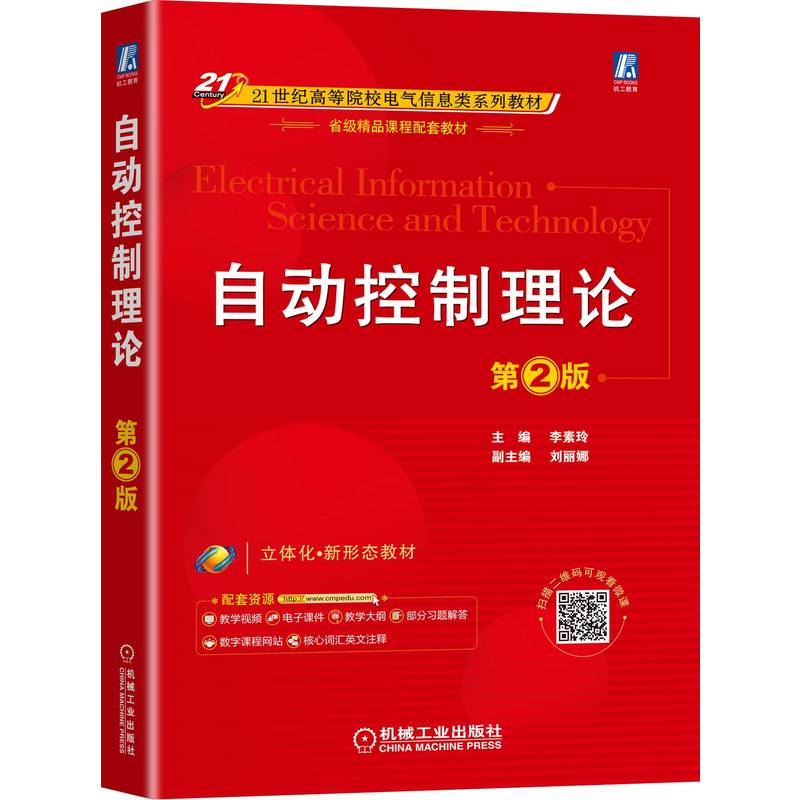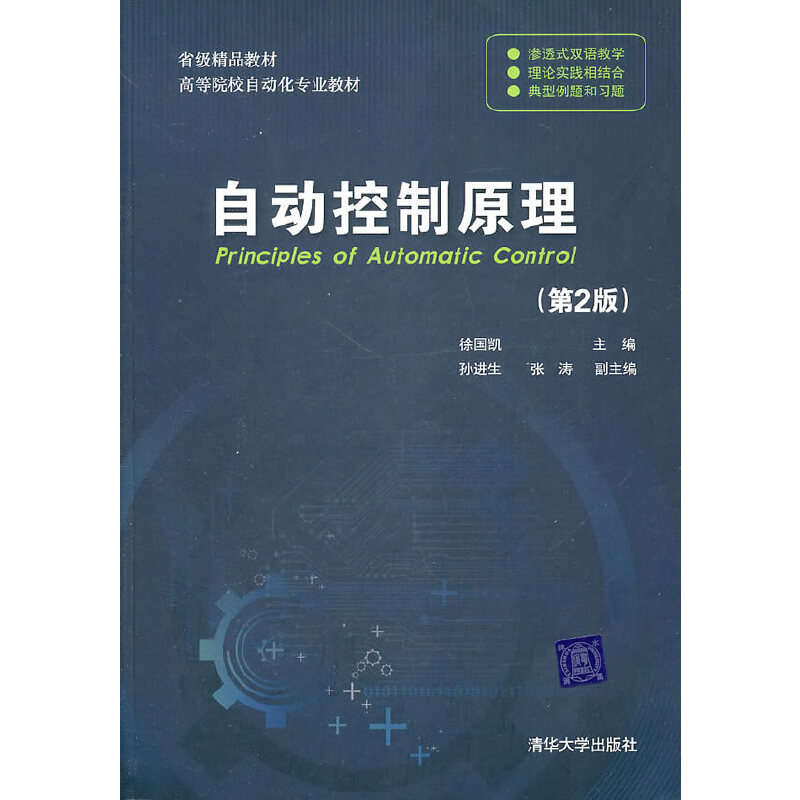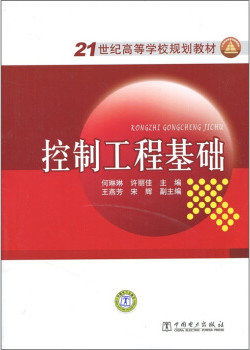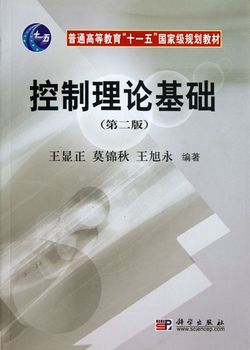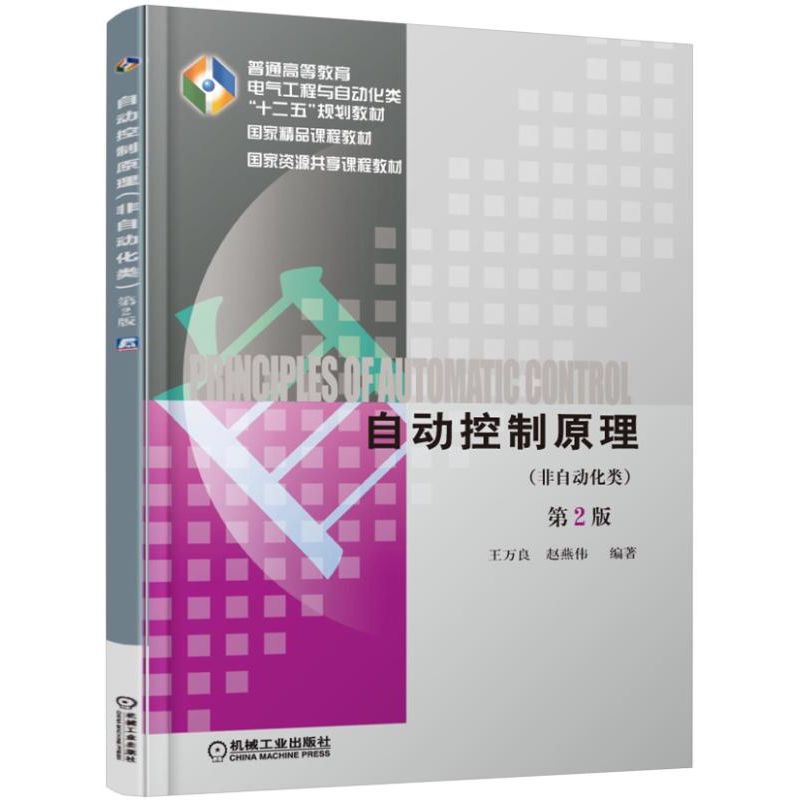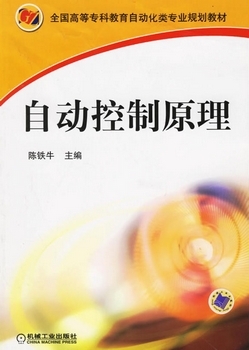- 机械工业出版社
- 9787111709824
- 2-2
- 434988
- 46255709-1
- 平装
- 16开
- 2022-07
- 577
- 359
- 电气工程与智能控制
- 本科
内容简介
本书以经典控制理论为主,较全面地介绍了自动控制的基本理论与应用。全书共分8章,分别是绪论、控制系统的数学模型、时域分析法、根轨迹分析法、频率特性分析法、控制系统的校正、线性离散控制系统、非线性控制系统分析。书末给出的3个附录可供读者在学习本书的过程中查询之用。
本书是新形态教材,读者可通过扫描二维码或登录数字课程网站(http://coursehome.zhihuishu.com/courseHome/1000064383#teachTeam)观看每个知识点的微视频、PPT等资源,教材中的定义、定理、重点内容和特性曲线等均用彩色进行了标注;本书按照“新工科”建设理念,从注重培养学生解决复杂工程问题能力的目标出发,每章含有学习指南、能力目标和学习建议;为了便于自学,各章均附有丰富的例题和练习题。
本书可作为电气与电子信息学科各专业,机械、化工、航空航天等非电类相关专业的本科生和研究生教材,也可供有关工程技术人员参考。
本书是新形态教材,读者可通过扫描二维码或登录数字课程网站(http://coursehome.zhihuishu.com/courseHome/1000064383#teachTeam)观看每个知识点的微视频、PPT等资源,教材中的定义、定理、重点内容和特性曲线等均用彩色进行了标注;本书按照“新工科”建设理念,从注重培养学生解决复杂工程问题能力的目标出发,每章含有学习指南、能力目标和学习建议;为了便于自学,各章均附有丰富的例题和练习题。
本书可作为电气与电子信息学科各专业,机械、化工、航空航天等非电类相关专业的本科生和研究生教材,也可供有关工程技术人员参考。
目录
目录(Contents)
第2版前言
第1版前言
第1章 绪论(Introduction)
学习指南(Study Guide)
1.1引言(General Introduction)
1.2自动控制系统概述(Overview of Automatic Control Systems)
1.3自动控制系统的分类(Categories of Automatic Control Systems)
1.4对控制系统的要求和本课程的主要任务(Requirements for Control Systems and Main Tasks of this Course)
本章小结(Summary)
代表人物及事件简介(Leaders and Events)
习题(Exercises)
第2章 控制系统的数学模型(MathematicalModel of Control Systems)
学习指南(Study Guide)
2.1引言(General Introduction)
2.2微分方程(Differential Equation)
2.3传递函数(Transfer Function)
2.4结构图及其等效变换(Structure Diagram and its Equivalent Transformation)
2.5信号流图与梅森公式(Signal Flow Graphs and Mason Gain Formula)
2.6闭环系统的传递函数(Transfer Function of Closed-Loop System)
2.7控制系统中数学模型的MATLAB描述(MATLAB Representations of Mathematical Models in Control Systems)
本章小结(Summary)
代表人物及事件简介(Leaders and Events)
习题(Exercises)
第3章 时域分析法(Time Domain Analysis Method)
学习指南(Study Guide)
3.1典型输入信号和时域性能指标 (Classical Input Signal and Time Domain Performance Index)
3.2一阶系统的时域分析(Time Domain Analysis for One-Order Systems)
3.3二阶系统的时域分析(Time Domain Analysis for Second-Order Systems)
3.4高阶系统的时域分析(Time Domain Analysis for Higher-Order Systems)
3.5线性系统的稳定性分析(Stability Analysis of Linear Systems)
3.6线性系统的稳态误差(Steady-State Error of Linear Systems)
3.7用MATLAB进行时域响应分析(Time Domain Response Analysis by Using MATLAB)
习题(Exercises)
第4章 根轨迹分析法(Root Locus Analysis Method)
学习指南(Study Guide)
4.1根轨迹的基本概念(Basic Concepts of Root Locus)
4.2绘制根轨迹的基本法则(Basic Rules of Plotting Root Locus)
4.3广义根轨迹(Generalized Root Locus)
4.4控制系统的根轨迹分析(Root Locus Analysis of Control System)
4.5用MATLAB绘制系统根轨迹图(Plotting System Root Locus by Using MATLAB)
本章小结(Summary)
代表人物及事件简介(Leaders and Events)
习题(Exercises)
第5章 频率特性分析法(Frequency Characteristic Analysis Method)
学习指南(Study Guide)
5.1频率特性的基本概念(Basic Concepts of Frequency Characteristics)
5.2典型环节的频率特性(Classical Elements of Frequency Characteristics)
5.3系统开环频率特性的绘制(Drawing Open-Loop Frequency Characteristics of a System)
5.4奈奎斯特稳定判据(Nyquist Stability Criterion)
5.5控制系统的相对稳定性(Relative Stability of Control Systems)
5.6用频率特性分析系统品质(Analysis of System Quality with Frequency Characteristics)
5.7系统传递函数的实验确定法 (Experimental Determination of System Transfer Function)
5.8 MATLAB在频域分析中的应用(Applications of MATLAB in Frequency Domain Analysis)
本章小结(Summary)
代表人物及事件简介(Leaders and Events)
习题(Exercises)
第6章 控制系统的校正(Compensation of Control Systems)
学习指南(Study Guide)
6.1系统校正的基本概念(Basic Concepts of System Compensation)
6.2常用校正装置及其特性(Commonly Used Compensators and its Characteristics)
6.3频率法串联校正(Frequency Cascade Compensation)
6.4频率法反馈校正(Frequency Feedback Compensation)
6.5 MATLAB在系统校正中的应用(Applications of MATLAB in System Compensation)
本章小结(Summary)
代表人物及事件简介(Leaders and Events)
习题(Exercises)
第7章 线性离散控制系统(Linear Discrete Control Systems)
学习指南(Study Guide)
7.1离散控制系统概述(Overview of Discrete Control Systems)
7.2信号的采样与保持(Signal Sampling and Holding)
7.3 z变换(z Transform)
7.4离散系统的数学模型(Mathematical Model of Discrete Systems)
7.5离散系统的动态性能分析(Dynamic Performance Analysis of Discrete Systems)
7.6离散系统的稳定性分析(Stability Analysis of Discrete Systems)
7.7离散系统的稳态误差分析(Steady-State Error Analysis of Discrete Systems)
7.8离散系统的校正(Compensation of Discrete Systems)
7.9 MATLAB在离散系统中的应用 (Applications of MATLAB in Discrete Systems)
本章小结(Summary)
代表人物及事件简介(Leaders and Events)
习题(Exercises)
第8章 非线性控制系统分析(Analysis of Nonlinear Control Systems)
学习指南(Study Guide)
8.1非线性控制系统概述(Overview of Nonlinear Control Systems)
8.2描述函数法(Describing Function Method)
8.3相平面法(Phase Plane Method)
8.4 MATLAB在非线性系统分析中的应用(Applications of MATLAB in Nonlinear Systems)
本章小结(Summary)
代表人物及事件简介(Leaders and Events)
习题(Exercises)
附录(Appendix)
附录A常用函数的拉普拉斯变换表(Table of Laplace Transform Pairs for Commonly Used Functions)
附录B拉普拉斯变换的一些定理 (Some Theorems of the Laplace Transform)
附录C常用函数的z变换表(Table of z Transforms of Commonly Used Functions)
参考文献(References)
第2版前言
第1版前言
第1章 绪论(Introduction)
学习指南(Study Guide)
1.1引言(General Introduction)
1.2自动控制系统概述(Overview of Automatic Control Systems)
1.3自动控制系统的分类(Categories of Automatic Control Systems)
1.4对控制系统的要求和本课程的主要任务(Requirements for Control Systems and Main Tasks of this Course)
本章小结(Summary)
代表人物及事件简介(Leaders and Events)
习题(Exercises)
第2章 控制系统的数学模型(MathematicalModel of Control Systems)
学习指南(Study Guide)
2.1引言(General Introduction)
2.2微分方程(Differential Equation)
2.3传递函数(Transfer Function)
2.4结构图及其等效变换(Structure Diagram and its Equivalent Transformation)
2.5信号流图与梅森公式(Signal Flow Graphs and Mason Gain Formula)
2.6闭环系统的传递函数(Transfer Function of Closed-Loop System)
2.7控制系统中数学模型的MATLAB描述(MATLAB Representations of Mathematical Models in Control Systems)
本章小结(Summary)
代表人物及事件简介(Leaders and Events)
习题(Exercises)
第3章 时域分析法(Time Domain Analysis Method)
学习指南(Study Guide)
3.1典型输入信号和时域性能指标 (Classical Input Signal and Time Domain Performance Index)
3.2一阶系统的时域分析(Time Domain Analysis for One-Order Systems)
3.3二阶系统的时域分析(Time Domain Analysis for Second-Order Systems)
3.4高阶系统的时域分析(Time Domain Analysis for Higher-Order Systems)
3.5线性系统的稳定性分析(Stability Analysis of Linear Systems)
3.6线性系统的稳态误差(Steady-State Error of Linear Systems)
3.7用MATLAB进行时域响应分析(Time Domain Response Analysis by Using MATLAB)
习题(Exercises)
第4章 根轨迹分析法(Root Locus Analysis Method)
学习指南(Study Guide)
4.1根轨迹的基本概念(Basic Concepts of Root Locus)
4.2绘制根轨迹的基本法则(Basic Rules of Plotting Root Locus)
4.3广义根轨迹(Generalized Root Locus)
4.4控制系统的根轨迹分析(Root Locus Analysis of Control System)
4.5用MATLAB绘制系统根轨迹图(Plotting System Root Locus by Using MATLAB)
本章小结(Summary)
代表人物及事件简介(Leaders and Events)
习题(Exercises)
第5章 频率特性分析法(Frequency Characteristic Analysis Method)
学习指南(Study Guide)
5.1频率特性的基本概念(Basic Concepts of Frequency Characteristics)
5.2典型环节的频率特性(Classical Elements of Frequency Characteristics)
5.3系统开环频率特性的绘制(Drawing Open-Loop Frequency Characteristics of a System)
5.4奈奎斯特稳定判据(Nyquist Stability Criterion)
5.5控制系统的相对稳定性(Relative Stability of Control Systems)
5.6用频率特性分析系统品质(Analysis of System Quality with Frequency Characteristics)
5.7系统传递函数的实验确定法 (Experimental Determination of System Transfer Function)
5.8 MATLAB在频域分析中的应用(Applications of MATLAB in Frequency Domain Analysis)
本章小结(Summary)
代表人物及事件简介(Leaders and Events)
习题(Exercises)
第6章 控制系统的校正(Compensation of Control Systems)
学习指南(Study Guide)
6.1系统校正的基本概念(Basic Concepts of System Compensation)
6.2常用校正装置及其特性(Commonly Used Compensators and its Characteristics)
6.3频率法串联校正(Frequency Cascade Compensation)
6.4频率法反馈校正(Frequency Feedback Compensation)
6.5 MATLAB在系统校正中的应用(Applications of MATLAB in System Compensation)
本章小结(Summary)
代表人物及事件简介(Leaders and Events)
习题(Exercises)
第7章 线性离散控制系统(Linear Discrete Control Systems)
学习指南(Study Guide)
7.1离散控制系统概述(Overview of Discrete Control Systems)
7.2信号的采样与保持(Signal Sampling and Holding)
7.3 z变换(z Transform)
7.4离散系统的数学模型(Mathematical Model of Discrete Systems)
7.5离散系统的动态性能分析(Dynamic Performance Analysis of Discrete Systems)
7.6离散系统的稳定性分析(Stability Analysis of Discrete Systems)
7.7离散系统的稳态误差分析(Steady-State Error Analysis of Discrete Systems)
7.8离散系统的校正(Compensation of Discrete Systems)
7.9 MATLAB在离散系统中的应用 (Applications of MATLAB in Discrete Systems)
本章小结(Summary)
代表人物及事件简介(Leaders and Events)
习题(Exercises)
第8章 非线性控制系统分析(Analysis of Nonlinear Control Systems)
学习指南(Study Guide)
8.1非线性控制系统概述(Overview of Nonlinear Control Systems)
8.2描述函数法(Describing Function Method)
8.3相平面法(Phase Plane Method)
8.4 MATLAB在非线性系统分析中的应用(Applications of MATLAB in Nonlinear Systems)
本章小结(Summary)
代表人物及事件简介(Leaders and Events)
习题(Exercises)
附录(Appendix)
附录A常用函数的拉普拉斯变换表(Table of Laplace Transform Pairs for Commonly Used Functions)
附录B拉普拉斯变换的一些定理 (Some Theorems of the Laplace Transform)
附录C常用函数的z变换表(Table of z Transforms of Commonly Used Functions)
参考文献(References)

